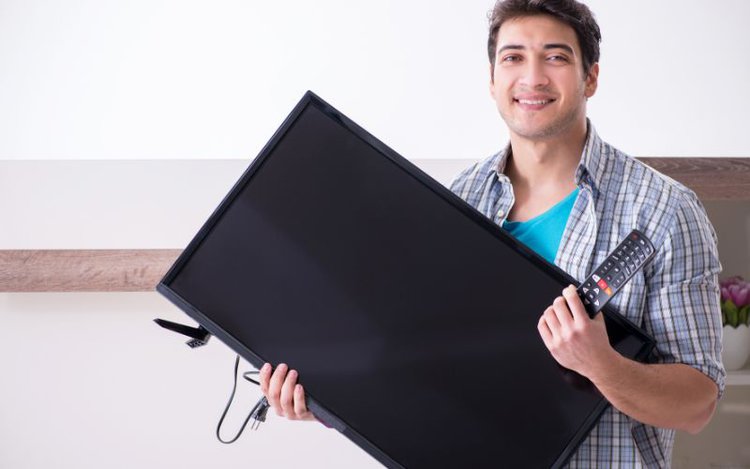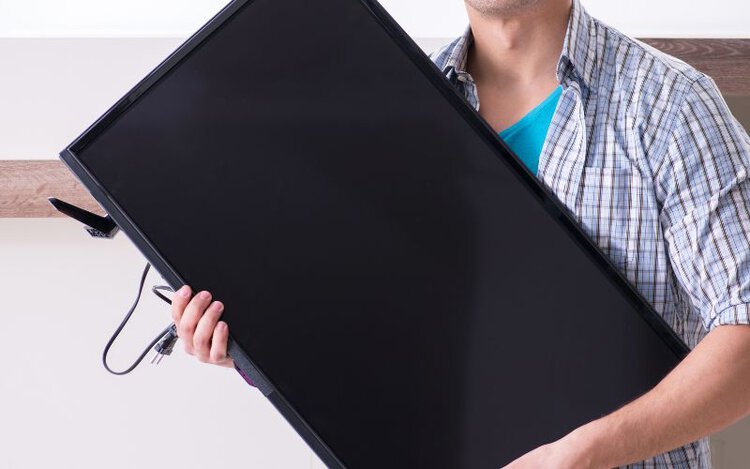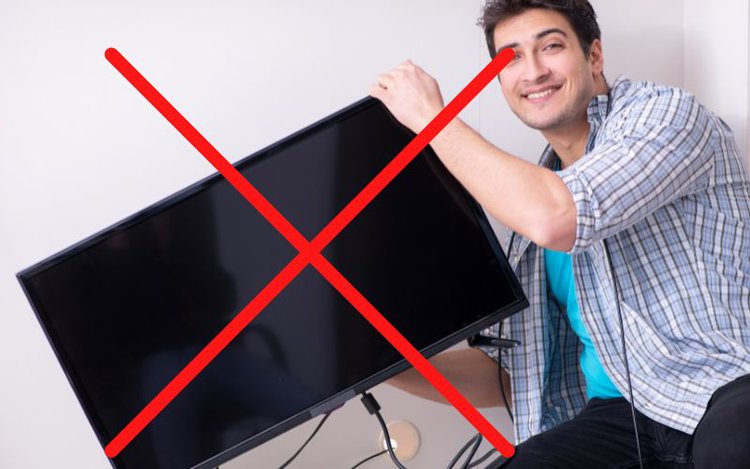How to Carry a Big TV By Yourself: 50, 55, 65 or 75-inch Screen?

What To Know
- Yes, you can carry certain sizes of TVs by yourself, but it’s contingent on the TV’s weight and your physical capability.
- A 55-inch TV is manageable for most, but sizes beyond that, especially 75-inch TVs, can be challenging due to weight and width.
- Always lift from the bottom in a squat position, clear paths, and plan breaks. Use aids (like a dolly) for heavier TVs. Ensure you’ve protective wrapping around the TV to avoid damage.
Moving a sizable 55, 65, or 75-inch TV alone can be daunting and risky.
How do you ensure safety while preventing potential damage to your TV? In this guide, we’ll address the concerns of solo handling and provide solutions for a secure move.
Let’s navigate this challenge together.
Quick Navigation
How Big Are 55, 65, and 75-Inch TVs?
Let’s go over how big a 55, 65, and 75-inch TV is.
Before we can discuss how big these different TV sizes are, it’s important to understand how TV screens are measured.
TV screens are usually measured diagonally, from one corner of the screen to the opposite corner. If you’re not sure how big your TV screen is, use a tape measure to measure from the upper right-hand corner to the bottom left-hand corner.
The TV’s weight will vary depending on the brand, type of TV, and whether it’s attached to a stand or not.
All the average TV weights listed below are rounded up to the nearest whole number.

How Big is a 55-Inch TV?
LED TVs will usually weigh 38 pounds (17 kilos) without their stand and 48 pounds (22 kilos) with it.
OLED 55-inch TVs are a bit lighter at 30 pounds (14 kilos) without the stand and 35 pounds (16 kilos) with the stand.
Plasma TVs are by far the heaviest at 53 pounds (24 kilos) without the stand and 57 pounds (26 kilos) with the stand.
How Big is a 65-Inch TV?
LED 65-inch TVs commonly weigh 52 pounds (24 kilos) without the stand and 57 pounds (26 kilos) with the stand.
OLED TVs typically weigh 49 pounds (22 kilos) with the stand weighing an additional 15 to 20 pounds (seven to nine kilos).
Plasma TVs should weigh about 77 pounds (35 kilos) on their own, and weigh 84 pounds (38 kilos) with the stand.
How Big is a 75-Inch TV?
LED 75-inch TVs come in at around 75 pounds (34 kilos), with another five to ten pounds (two to five kilos) with the stand.
OLED TVs weigh in at 64 pounds (29 kilos), though they will be slightly heavier with the stand.
Plasma TVs weigh the most at upwards of 100 pounds!
Can I Carry a 55, 65, or 75-Inch TV Alone?
Although challenging, depending on the size of your TV, it is possible to carry it alone.
55-inch TVs are the lightest and the easiest to carry alone, but anything bigger may be difficult. It may be challenging to hold onto a wide TV, especially if it’s wider than your arm span.

Your ability to carry a TV by yourself will also depend on your strength and anatomy. For instance, a five-foot-two person is going to have more difficulty carrying a TV than someone who is six feet tall.
Additionally, every TV will be different, as some TV models are heavier than others.
But the thing you should pay the most attention to is how you hold the TV. Squeezing either size of your flat screen TV can distort the screen or break it, resulting in dead spots and cracks.
Luckily, anything is possible with the right planning.
How Am I Supposed To Lift a TV?
Follow our guidelines for lifting a TV.
Before picking up the TV, wrap the TV with soft blankets, towels, or bubble wrap to cushion it. This will protect your TV’s screen and frame from dents or cracks if you bump into something or drop it, in the worst-case scenario.
Holding TVs from their sides can damage them as you could accidentally push the sides together and crack the screen. For this reason, it’s always best to lift a TV from the bottom.

If you’re not sure if you’re strong enough to carry the TV by yourself, try lifting it slightly off the ground or its mount to see how it feels.
It’s better that you know it’s too heavy for you before fully committing to carrying it by yourself without having a place to put it down if you need a break.
If the TV is light enough for you to carry without assistance, get into a squat position, take hold of both bottom corners of the TV, and lift it using your legs. Do not bend over to pick your TV up or you risk hurting yourself.
If your TV is too heavy for you to carry by yourself, use a dolly, wheely chair, or other pieces of furniture with wheels.
Bring the furniture with wheels next to your TV and lower it, if possible. Lift one corner of your TV onto the furniture’s base, then lift the other corner off the ground, and carefully slide it on.
It’s recommended that you keep the TV balanced standing up while moving it, but if you can’t, lay it down face up. Never lay flatscreen TVs screen-down.
Be gentle when putting your TV back down so you don’t injure yourself or break the TV.
Tips for Carrying a Big TV
Follow our tips and tricks for carrying a larger TV.
Carrying a big TV can be tricky, but we’re here to help. See our tips to keep both you and your TV safe during transportation.
Safety First
Before carrying a big TV, make sure you can actually lift it without hurting yourself. It’s always better to ask and wait for help than to break your back trying to do something yourself.

If you have back problems, try using a back belt, like the FEATOL Back Brace.
- 💯[3D Silicone Lumbar Pad] - FEATOL lower back brace with ergonomically designed 3D silicone...
- 👍[PAIN RELIEF]- The FEATOL lumbar support belt is effective in relieving pain caused by disc...
- 💯[WIDE COMPRESSION] - One-piece high-elastic fabric with velcro provides wide compression for...
Last update on 2024-07-18 / Paid Link.
The old adage is true: lift with your legs, not your back. This means it’s crucial to lift in a squat position, rather than by bending at your waist.
Make sure you’re correctly positioning yourself when carrying your TV by practicing the position before picking it up.
For safety reasons, we don’t recommend carrying a TV down or up stairs by yourself.
Keep your cellphone on you, so you can call for help in case you hurt yourself.
Clear a Path
Your big TV may block your vision while carrying it, putting you at risk of tripping, falling, or hurting yourself.
Plan which path you’ll take when carrying the TV and pick up anything on the floor. Make sure there’s no furniture in the way that you could bump into.
If you have any pets, we recommend locking them in another room so you won’t trip on them while carrying the TV.
Check that there’s nothing slippery on the floor, like any rugs or spills.
Plan for Breaks
If the TV is too heavy for you to carry from point A to point B without breaks, plan places where you can stop for a moment.

Make sure there are surfaces for you to set the TV on for a few seconds to give yourself a break so you don’t over-tire and drop the TV.
You may need a break every few feet, so plan accordingly and consider moving your furniture around to give yourself resting spots.
Wrapping Things Up
Sometimes you just have to do things yourself!
As a rule of thumb, always lift any flatscreen TV from its bottom, never the sides.
When carrying a TV alone make sure you know your limits and are realistic about your strength. TVs can weigh upwards of 100-pounds, so you must consider your health before lifting them yourself.
Keep your phone in your pocket in case you fall and hurt yourself and need to call for help.
What’s your experience carrying a big TV by yourself? Let us know in the comments below!
Yesenia Achlim is a technical copywriter and editor with a focus on AV equipment. She aims to break down complicated topics and make technology accessible, no matter your technical expertise. When she’s not teaching you how to replace a projector lamp, you can find her reading and baking.


